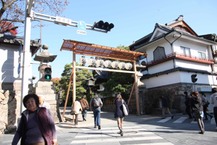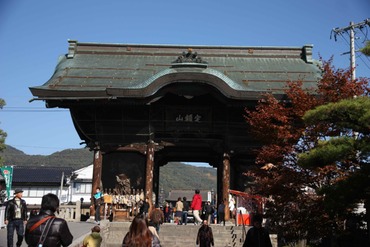Sunday, 4 November 2012

With the travelogue backlog mostly caught up, thanks to a couple of hours on the local train the day before and a two hour stint in the morning it was time to turn the attention to the day's proceedings, which were rather straightforward.
We'd take a walk around the city in the morning, returning to the hotel to collect the Black Monster and heading to the station for a connection to Nagoya and thence to Okayama, where we had an evening appointment with some combination of ramen noodles and tapas, though probably not in the same sitting.
Best known as the venue for the 1998 Winter Olympics, Nagano sits surrounded by 3000-metre summits, and a morning glance through the hotel window revealed snow capped peaks at a comfortable remove from the immediate vicinity. The Prefecture, of which Nagano is the capital, is known as the Roof of Japan and since it lies between the Kanto and Kansai regions, local customs have been influenced by the cultures of both eastern and western Japan. As the regional capital, Nagano serves as the transport hub for the surrounding snow resorts, with handy road and rail links to most of Japan's major centers, including Tokyo, Nagoya, Kyoto and Osaka. It's about an hour and a half from Tokyo by Shinkansen on the Hokuriku Line, also known as the Nagano Shinkansen or Asama, a legacy of the 1998 Winter Olympics with two or three departures per hour from Tokyo Station.
There is, however, a more scenic approach via the Wide View Shinano limited express that runs hourly from Nagoya, a three hour journey that takes you up (or in our case since we headed in the opposite direction, down) through the central cordillera and provides a route that's almost as scenic as the rail motor line from Toyama to Nagoya that passes through Takayama.
That one was one of the highlights of our 2008 trip, and if it subsequently seems I'm a little under-enthused about this leg of the journey it's coming on the end of a trip through Tohoku that has delivered multiple highlights of the autumn leaves variety. But if you're heading to Nagano from anywhere in western Japan, and Kyoto or Osaka in particular it's the best option, with one important caveat that comes into effect a little further down the page.
The Shinano is notorious for running late and had us scurrying to get to the right platform when we arrived in Nagoya. If you're headed into Nagano and planning to spend the night there, of course, difficulty making connections won't be an issue.

Originally a small town built around the hilltop 7th century Buddhist temple, the largest wooden building in eastern Japan, Nagano attracts a million tourists every year, drawn to the snow resorts, golf courses, a variety of sights and the natural hot springs found throughout the mountain areas. Nagano is also noted for a variety of culinary products including soba noodles, apples and sake, oyaki dumplings, gohei mochi snacks, and bamboo leaf-wrapped sasa-zushi.
Founded in the seventh century, Zenkoji is one of the most popular temples in Japan, and while it sees a stream of visitors the most significant feature of the temple is only shown to the public for a couple of weeks every six years. Zenkoji houses the first Buddhist statue brought into Japan when Buddhism was first arrived in the sixth century. The original hibutsu (hidden Buddha) is permanently hidden and what will be on display again in 2015 is a replica.